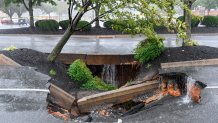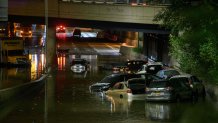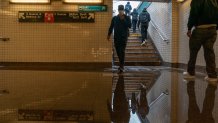Many parts of the Northeast U.S. saw a "100-year flood" in 2020 when Isaias barreled up the coast after causing widespread damage in the Caribbean. Now in 2021, we're talking about century-old records again.
The remnants of Hurricane Ida damaged Pennsylvania, New Jersey, New York and Connecticut Wednesday night, as record-setting rainfall flooded streets and homes and low-hanging clouds spawned some dangerous tornadoes in an area that rarely sees them.
In New York City's Central Park, Ida smashed the record for hourly rainfall set by Henri just last month, according to NBC New York. In the city of Philadelphia, Interstate 676 and 76 were underwater, looking more like canals in Venice, Italy than major highways. In South Jersey, a tornado ripped several homes apart.
Here's a look at some of the damage Ida caused after it tore through Louisiana.
Rainwater formed a sinkhole in this PA parking lot

NYC-area highways flooded, stranding cars in water

Floodwaters also reached the New York subway system

Meanwhile, towns like Houma, LA are still cleaning up
How climate change plays a role in storm strength
One effect of climate change is that our oceans are absorbing more excess heat - and that increased water temperature can intensify storms.
"The research confirms that we are now in the Atlantic twice as likely to see a Category 3, 4 or 5 storm," NBC Miami Meteorologist Steve MacLaughlin said recently. "Once a system forms and gets going, it is more likely to become a major hurricane."
Those strengthened storms can also move more slowly while dropping more rain.
Can old infrastructure keep up with stronger storms?
More than 20 million Americans are protected by levees, but those levees are getting old - and recently received a D grade from the American Society of Civil Engineers.
That puts many parts of the U.S. at risk for devastating floods.
"The problem is our need is very large, and it's only been exacerbated by the extreme storm events we're seeing and the number of flood events we're seeing in terms of the Ohio River flooding, brought on by climate change," said Tony Parrott of the Metropolitan Sewer District in Louisville, Kentucky.
The city could face flooding worse than Katrina if its levee system were to fail. And many flood-prone areas including Louisville rely on aging pumping stations that may not be able to keep up with large volumes of water coming more frequently.
"Folks need to understand that climate change is real. Many cities are dealing with rising floodwaters and dealing with aging infrastructure. And we would hope that it would not take a catastrophic event to really raise awareness to folks on how critical these assets are," Parrott said.
Joe Brandt, Chase Cain, Eric Alvarez and Jeremy Berg contributed to this report.

